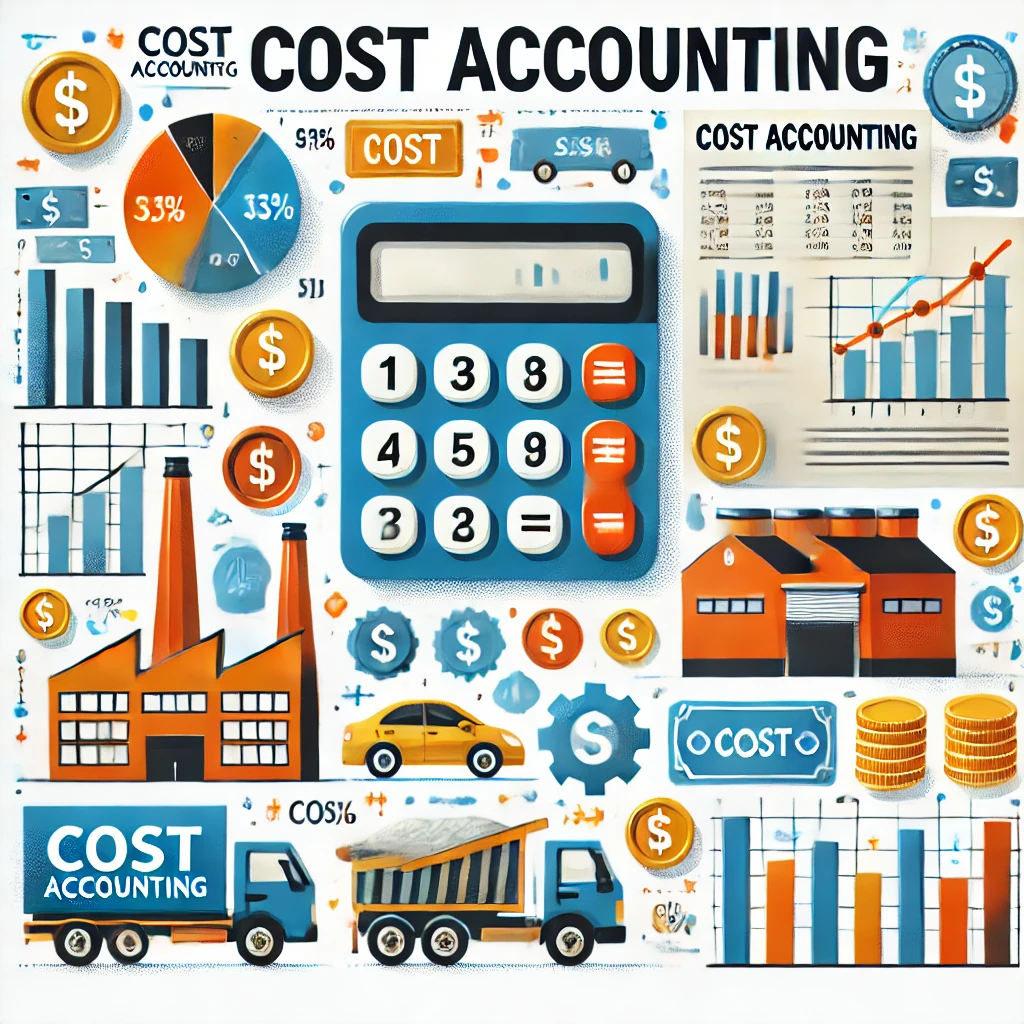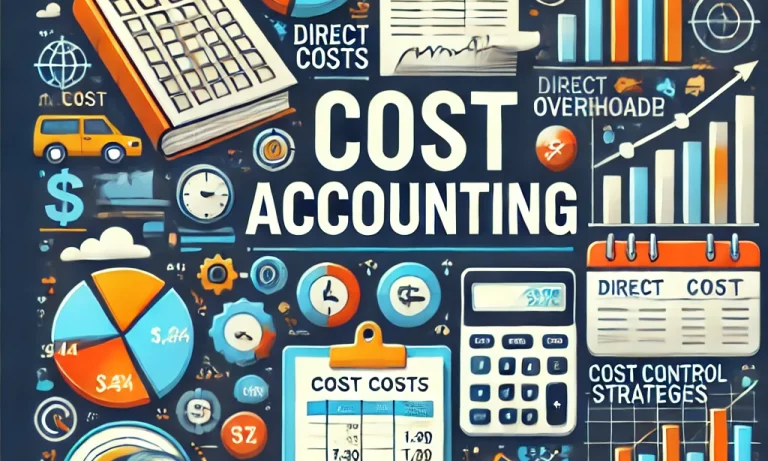Cost accounting is the branch of accounting that focuses on the recording, classification, and analysis of costs for goods or service production. Providing a breakdown of the expense incurred during the manufacturing process or provision of services assists a firm in making sound decisions concerning pricing, cost control, and profitability. In this chapter, we’re going to do cost accounting very in-depth, focusing on its definition, objective, advantages, and disadvantages, scopes, and functions of cost accounting along with functions, methods of cost accounting, various kinds of costing, kinds of overhead expenses, ways and methods the overheads account dealt with this accounting subject.
Cost Accounting Definition
Cost accounting is recording, tracking, and analytical reporting of costs incurred while producing goods or services through a business. It, therefore, is primarily computing the cost of all materials, labor, and overhead used in production, keeping a business up to optimal efficiency and cost management. Unlike financial accounting, which focuses on preparing financial statements for external use, cost accounting is used internally by management to make decisions that enhance profitability and reduce costs.
Key Components of Cost Accounting
- Direct Costs: These are costs directly attributed to the production of goods or services, such as raw materials and labor.
- Indirect Costs: These are costs that cannot be traced directly to a specific product, such as overheads.
- Fixed Costs: Costs that remain constant regardless of the level of production or sales, such as rent or insurance.
- Variable Costs: Costs that vary directly with production volume, such as raw materials or labor costs.
- Semi-Variable Costs: These costs have both fixed and variable components, such as electricity bills or telephone charges.
By understanding these cost categories, businesses can develop more effective budgeting and cost-control strategies.

Objectives of Cost Accounting
Cost accounting serves several important objectives, helping businesses manage their finances more effectively. These objectives are essential in achieving profitability, efficiency, and cost control.
- Cost Control and Reduction: The most important objectives of cost accounting are to allow managers to have the finest details about costs, and hence identify areas where costs could be reduced or controlled. On analyzing costs, managers can zero in on inefficiencies and take corrective action such as renegotiating supplier contracts or optimizing labor usage.
- Pricing Decisions: Cost accounting helps businesses set competitive and profitable prices for their products or services. Knowing the exact cost of production allows companies to determine the minimum price they need to charge to break even and ensure profitability.
- Profitability Analysis: Cost accounting enables businesses to analyze the profitability of their different products or services. By calculating the cost per unit and comparing it with sales revenue, businesses can determine which products or services are contributing most to their bottom line.
- Budgeting and Forecasting: With proper cost data, a business can set a realistic budget and forecast. It will help plan for future financial needs and set realistic targets for profitability and growth.
- Decision-Making Support: Cost accounting provides crucial data for make-or-buy decisions, whether to continue or discontinue certain product lines, and optimal production methods.
Overall, cost accounting provides businesses with the tools to make data-driven decisions that improve their financial performance.
Advantages of Cost Accounting
Cost accounting has several advantages that help organizations operate efficiently and maintain a comparative advantage. These benefits are crucial in helping minimize waste, controlling costs, and maximizing profitability.
- Improved Cost Control: With accurate and detailed information on the costs associated with each product or service, businesses can identify and eliminate inefficiencies. Cost accounting makes it easier for companies to track costs and establish cost-control measures.
- Better Budgeting and Financial Planning: Cost accounting provides the foundation for effective budgeting. By understanding fixed and variable costs, companies can create more accurate financial projections, ensuring they remain within budgetary constraints.
- Enhanced Profitability: By tracking costs at each stage of production, businesses can pinpoint areas where cost-cutting measures can be implemented, thus increasing profit margins. Understanding the costs associated with each unit of production allows companies to adjust pricing strategies and production methods to achieve higher profitability.
- Effective Pricing Decisions: With cost accounting, businesses can determine the true cost of production and set prices accordingly. Accurate pricing ensures that businesses maintain profitability while staying competitive in the market.
- Informed Decision-Making: Cost accounting helps managers make informed decisions based on real-time data. Whether the decision involves product line changes, cost-cutting strategies, or investment opportunities, the data provided by cost accounting supports strategic decision-making.
Limitations of Cost Accounting
While cost accounting has many benefits, it also has certain limitations that businesses need to consider when applying it. Understanding these limitations helps companies avoid potential pitfalls and make better use of cost accounting practices.
- Subjectivity in Cost Allocation: One of the biggest drawbacks of cost accounting is the subjective nature of indirect cost allocation, such as overhead. Different methods may lead to different results, and choosing the right method is quite complicated.
- Time-Consuming and Expensive: It takes a lot of time and resources to implement a cost accounting system. A business may have to spend on specialized software or additional staff, which may be costly.
- Complexity in Multi-Product Businesses: In multi-product businesses, cost allocation can become highly complex. The need to allocate costs fairly to each product line demands a detailed understanding of cost behavior and production processes, which is hard to manage.
- Non-Financial Factors: Cost accounting primarily involves financial data, but, in doing so, will often miss non-financial factors that may have an impact on decision-making. Some examples include the environmental impact of specific production processes or the strategic benefits of certain decisions made far into the future.
- Misleading Information: The cost accounting system may provide misleading information if it is not designed correctly. For instance, misallocation of overhead costs can lead to wrong cost computation, which in turn can result in incorrect pricing decisions.
While these limitations exist, businesses can mitigate them by continuously refining their cost accounting methods and using them alongside other management tools.
Scope of Cost Accounting
The scope of cost accounting extends beyond simply tracking production costs. It encompasses various activities and processes that help businesses monitor and control their financial performance.
- Cost Allocation: One of the key functions of cost accounting is to allocate costs to different cost centers, departments, or production processes. The allocation of costs helps track how much is being spent in each area and will help identify where cost savings can be made.
- Cost Analysis: Cost accounting also involves analyzing costs in order to identify trends, inefficiencies, and areas for improvement. For instance, a business can analyze fixed costs versus variable costs to determine the impact of production scale on profitability.
- Cost Forecasting: Cost accounting helps in forecasting future costs based on historical data and production trends. This helps businesses plan for future financial needs and set budgets accordingly.
- Inventory Valuation-Inventory valuation is another important element of cost accounting. For determining the profitability and stock levels of the product, it needs to value the inventory through proper cost accounting methods.
- Product Costing: These cost accounts calculate the production cost of a product, containing both direct and indirect expenses. It helps businesses make proper pricing strategies by knowing all the total costs of different products.
Overall, the scope of cost accounting covers every aspect of cost control, financial analysis, and decision-making, making it a vital tool for businesses.
Types of Cost Accounting
There are many different types of cost accounting methods that a business can use, depending on its needs and the nature of its operations. Each type of cost accounting offers unique advantages and applies to specific types of businesses, depending on their structure of operations.
- Standard Costing: Standard costing is a cost accounting method that determines predetermined costs for materials, labor, and overhead. Then, actual costs are compared to the predetermined costs to identify variances and evaluate performance.
- Job Order Costing: In job order costing, costs are accumulated on particular jobs or batches of production. This technique is used where products are made to order, such as in construction or custom manufacturing.
- Process Costing: Process costing applies in industries that have manufactured products through continuous processes like chemical and food manufacturing. The company applies average costs to the products produced within a time.
- Activity-Based Costing (ABC): The activity-based costing involves the assignment of costs to products according to the activities involved in making those products. This method is relatively more accurate than the traditional method because it provides the actual distribution of overhead costs according to resource usage.
- Marginal Costing: The marginal cost concerns the variable cost of producing one extra unit of output.
It provides a basis for business decision-making on issues of pricing, production quantity, and product mix selection.
Functions of Cost Accounting
Cost accounting plays an important role in managing the finances of a business as it performs a number of functions, which help in decision-making and cost control. The performance of such functions enables cost accounting to improve the financial performance of businesses and make strategic decisions that can enhance profitability.
- Cost Measurement: One of the major purposes of cost accounting is cost measurement, that is, to measure the cost incurred in the production process. This involves direct and indirect cost tracing and finding the cost per unit of output.
- Cost Control: Cost accounting also assists in cost control since it helps in determining areas where costs are above budgeted levels. Monitoring and analyzing cost data can lead to corrective actions on the part of the managers to control costs.
- Cost Planning and Budgeting: Cost accounting is an essential part of financial planning and budgeting. It gives the information necessary to develop proper cost predictions and set appropriate budgetary targets.
- Decision Support: Cost accounting helps managers make decisions on pricing, product mix, outsourcing, and production processes. The information given enables managers to choose the most cost-effective options.
- Performance Analysis: Cost accounting allows a company to compare the performance of departments, products, or projects based on cost efficiency. It helps to identify areas of improvement and reward the high-performing units.
Overheads in Cost Accounting
Overheads cannot trace indirect costs of production directly to specific products. Overhead management is a significant concern in cost accounting since overheads have to be distributed or allocated to products appropriately to determine the correct price and profitability.
Classification of Overheads
Overheads can be broadly classified into three categories
- Factory overheads: These include rents and utilities
- Administrative overheads: These include office salaries.
- Selling and distribution overheads: These include advertising costs.
Allocation of Overheads
Overhead allocation is an arduous task, for the use of overheads for products is not direct. Generally speaking, companies can allocate overheads over direct labor hours, machine hours, or production units.
Importance of Overhead Allocation
Proper overhead allocation is vital for the proper costing and pricing of products. Otherwise, overheads may be under or over-allocated in a business. In such a case, businesses may set prices that are either too low or too high, which could result in losses.
Control of Overheads
Cost accounting provides techniques for overhead cost control. Regular analysis of overhead costs can help businesses pinpoint inefficiencies and take corrective actions to reduce waste.
Cost Accounting FAQs
What is cost accounting?
Cost accounting is a method of recording, classifying, and analyzing the costs of goods or services. It helps businesses track expenses, set prices, and make informed financial decisions.
What are the objectives of cost accounting?
The objectives of cost accounting include cost control, budgeting, profitability analysis, pricing decisions, and supporting decision-making. These enhance business efficiency and profitability.
What are the types of cost accounting?
The main types of cost accounting include job order costing, process costing, activity-based costing (ABC), standard costing, and marginal costing. Each method is suitable for different industries and production processes.
What are overheads in cost accounting?
Overheads in cost accounting refer to indirect costs such as factory rent, utilities, and office salaries. These costs cannot be traced directly to a specific product but must be allocated based on certain criteria.
What are the limitations of cost accounting?
Limitations of cost accounting include subjectivity in cost allocation, time-consuming processes, complexity in multi-product businesses, and the potential for misleading information if not set up correctly.


